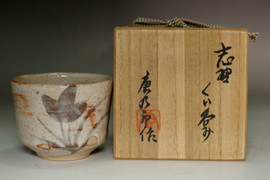Kato Tokuro (1896-1985) Vintage shino ware cup #4008
- SKU:
- 4008
- Shipping:
- Free Shipping
- width: approx. 7cm (2 3⁄4in)
- height: approx. 4.7cm (1 27⁄32in)
- weight: 106g (gross 195g)
Kato Tokuro (1896-1985)
Kato Tokuro was born the eldest son of Seto potter Kano Sojiro, and as a child displayed a talent for painting in the Nanga style, for composing Chinese poetry, as well as for ceramics, which he practiced under his father. In 1914, he was granted partial rights to his father's round kiln, marking the start of his own kiln construction and ceramics.
In 1918, he married Kato Kinu and took the family name Kato.
He devoted himself to surveying the old Seto kilns and researching traditional Seto techniques, allowing him to reproduce Shino and Oribe ware. In 1929, he founded the Society for the Surveying and Preservation of the Old Seto Kilns. In 1930, he qualified for the Art Aichi Society Exhibition and began associating himself with fellow promoters of folk art movements, such as Yanagi Muneyoshi, Kawai Kanjiro, and Hamada Shoji.
After the war, Kato founded and became the first chairman of the Japan Ceramics Society in 1947, formed the Tori Society together with Ishiguro Munemaro, Kaneshige Toyo, Arakawa Toyozo, Kato Hajime, and others in 1954, and won the Chunichi Cultural Award in 1956.
Tokuro became a director of the Japan Kogei Association in 1957 and a lecturer at the School of Letters, Nagoya University in 1958, but completely withdrew from any public work after the Einin Pot Scandal of 1960. Instead, he devoted himself to the free pursuit of ceramics as an unaffiliated potter. In 1961, he was even bestowed the pen name Ichimusai by poet Hattori Tanpu, after which he signed works Ichimusai or Ichimu.
Moreover, although he was designated as the 1st Intangible Cultural Heritage Technician (today referred to as Living National Treasure), he was stripped of this after the Einin Pot Scandal. A master of potter's wheel techniques, Tokuro recreated the Shino and Oribe ware of the Momoyama period by restoring that period's clays, glazes, and kilns as well as devoted his life to creating reference material on ceramics, such as the Encyclopedia of Japanese Ceramics (Kodansha). After such a long life of contributions to the world of ceramics, he completed his own Akane-Shino in 1977.
His sons include eldest son Okabe Mineo and third son Kato Shigetaka.
The Einin Pot was an earthenware pot that Tokuro had marked as coming from the Einin period (1293–1298) in 1937, which was later designated as a Important Cultural Heritage in 1959 through the strong promotion of Koyama Fujio. It was then discovered that the pot was not from the Einin period but made by Tokuro. Since the pot was included in a ceramics dictionary edited by Tokuro himself, this incident developed into a fraud scandal that shocked all of Japan, but Tokuro's ability to imitate the ceramics of that period so skillfully has also been highlighted since.

















